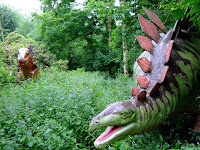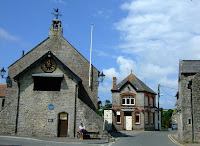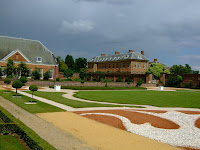There was one main attraction that we had yet to visit: Aya Sofya, so it was the focus of our tourist-beating early start this morning.

Built in the 6th century by, possibly, 10,000 men it was, for over 1000 years, the largest enclosed space in the world. The dome spans 30m and rises to nearly 57m above the floor, approximately equivalent to a 17-storey building, a truly amazing feat of design and engineering for the time.
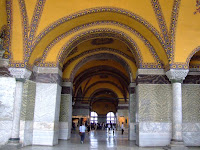
Like the Blue Mosque, the main dome rests on semi-domes but the significant difference is that the Blue Mosque has four huge pillars supporting the dome whereas the Aya Sofya appears to have none.
Built as the greatest church in Christendom, it was converted to a mosque when the Turks took the city in 1453 then deconsecrated and classified as a museum by Ataturk in 1934.

Although it has suffered a chequered history some magnificent mosaic works remain.
The remaining ‘must-do’ was a Bosphorus Cruise so we headed back down to the waterfront. The first boat we came across had a man intercepting likely punters and offering a 2-hour cruise to the second bridge, with a half-hour stop for YTL30; we pressed on. The next boat salesman offered the same deal for YTL20, but we pressed on as we had done our research the day before and knew that just past the bridge was a boat offering a 1½-hour cruise for YTL7.50

So we paid our fare and enjoyed the ride out of the Golden Horn, across the Bosphorus to the Asian side, up under the two huge suspension bridges and back again. I would not class it as unmissable if you were short of time in Istanbul but it was a pleasant enough way to spend a couple of hours.
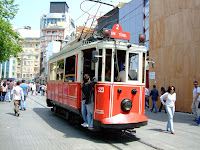
Since we were at the bridge that crossed the Golden Horn, we walked across to the far side, the Beyoglu area, then caught a tram and funicular to Taksim Square and wandered back downhill to the bridge with a detour to the Galata Tower.

There has been a tower on this site since 528, the current one being constructed in 1348 and repaired and restored a few times since. The views from the top are worth the YTL10 charge.
Up until this point we had managed to avoid the entreaties of the carpet salesmen and on the walk back to the hotel wandered through the Cifte Hamam (Double Bath) that sits by the square between the Aya Sofya and the Blue Mosque.

It is home to a government run display of carpets from the various regions of Turkey and, unlike the carpet shops in the city, the carpets are all displayed for you to wander through and inspect. From what we can work out, the Ministry of Culture and Tourism has scoured the museums of Turkey and the world for the best examples of Turkish carpets and kilms and then commissioned copies of these culturally important works. Fatal mistake!

One of the carpets leapt off the rack and said, “Buy me.” The next day before we left Istanbul, we went back for another look, only to find all the racks bare and to hear that they were packing up and leaving. So we pointed to the empty space the carpet had occupied and said that we wanted that one. A few seconds later it appeared from a pile and we had done the proper tourist thing, visited Turkey and purchased a Turkish carpet.
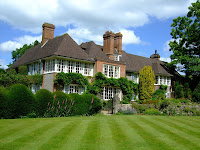 Nuffield Place was the home of Lord and Lady Nuffield, formerly Mrs & Mrs William Morris. Not the William Morris of interior design but the man behind the Morris motorcar. Ultimately it was not only Morris but Riley, Wolseley, M.G. and Austin that entered the Morris fold.
Nuffield Place was the home of Lord and Lady Nuffield, formerly Mrs & Mrs William Morris. Not the William Morris of interior design but the man behind the Morris motorcar. Ultimately it was not only Morris but Riley, Wolseley, M.G. and Austin that entered the Morris fold. In his lifetime Morris gave away over £30 million (the equivalent of several billion today) and, as he had no children, intended to divest himself of his entire fortune. He eschewed pretension and the house is comfortably but not ostentatiously furnished for the home of one of the richest men of his generation.
In his lifetime Morris gave away over £30 million (the equivalent of several billion today) and, as he had no children, intended to divest himself of his entire fortune. He eschewed pretension and the house is comfortably but not ostentatiously furnished for the home of one of the richest men of his generation. An interesting insight into his lifestyle is a workshop built into a cupboard in William’s bedroom: a place where he would repair his own shoes or tinker with other mechanical bits and pieces.
An interesting insight into his lifestyle is a workshop built into a cupboard in William’s bedroom: a place where he would repair his own shoes or tinker with other mechanical bits and pieces. This would be a great shame as the house is a unique example of a complete furnished 1930s home of a great industrialist and philanthropist.
This would be a great shame as the house is a unique example of a complete furnished 1930s home of a great industrialist and philanthropist. We had started the day with a walk along the Thames near the village of Goring and ended the day overlooking the Thames from the gardens around Taplow Court. Once the site of a monastery, it is now a Buddhist centre.
We had started the day with a walk along the Thames near the village of Goring and ended the day overlooking the Thames from the gardens around Taplow Court. Once the site of a monastery, it is now a Buddhist centre.


